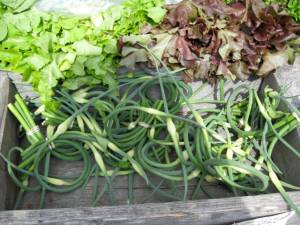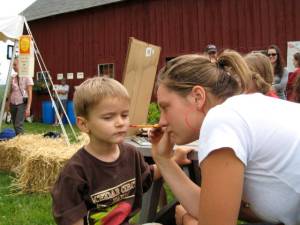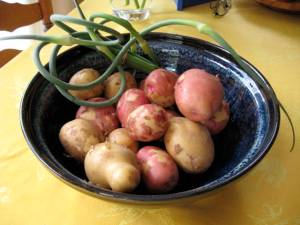Strawberries and scapes, strawberries and scapes…
Fresh, abundant, ephemeral. If we eat as much as we can every day, will the pleasure somehow last?
Posted in Whimsical, tagged garlic scapes on June 29, 2009| Leave a Comment »
Strawberries and scapes, strawberries and scapes…
Fresh, abundant, ephemeral. If we eat as much as we can every day, will the pleasure somehow last?
Posted in Vegetables, tagged Amy Campion, eat local Vermont, eating locally, garlic mashed potatoes recipe, garlic scapes, locavore, roving locavore, Vermont locavore on June 29, 2009| 1 Comment »

scapes bin at the Norwich Farmers' Market
I love garlic mashed potatoes. Possibly even more delicious are mashed potatoes made with garlic scapes. Last night, I boiled about a pound of new red and gold potatoes (skin on). I tossed four curlicues of garlic scapes (1 per person) into the boiling water for a minute, just to soften them up a bit. Then I roughly diced and minced them. When the potatoes were fork tender, I used a hand-masher to blend in the scapes, milk, 2 tbs. of butter, salt and pepper. The result was delicious, and as pretty as a pile of potatoes can be: creamy white flecked with green and pink, and tasting of the freshest garlic. I love whole roasted bulbs of garlic, with that deep nutty caramelized flavor, mashed into potatoes. This was different. Garlicky, but greener, grassier, springy.
The only problem was that I made too few. Everyone wanted more potatoes.
Posted in Fruit, Ice Cream, Sweet Things, Trends, Whimsical, tagged Amy Campion, Amy Campion food, Cedar Circle Farm, eat locally Vermont, locavore, organic strawberries, roving locavore, Vermont locavore, Vermont organic strawberries on June 28, 2009| Leave a Comment »

Strawberries were the totems of childhood today, at Cedar Circle Farm’s 7th annual strawberry festival. Of the milling, stooping, picking, licking population, about two-thirds were fewer than four feet tall. Many wore the totem on their shirts, hats, or cheeks. The folks at Cedar Circle make this day as much a celebration of childhood as of strawberries and local food in general. There were three horse-drawn wagons, a mural-drawing section of the barn wall, a coloring station, face-painting teenage girls, a sandbox, strawberry smoothies and shortcake, coffee for the parents, puppetry, kite-making, tractors to sit on, and live music. And, of course, picking.


We hit the face-painting table first; the boys both got trucks.

my son, the sceptic

Then we walked around the food stations. There were local sausages from Hogwash Farm on the grill, organic pizzas cooking in a wood-oven on wheels, and strawberry shortcake with whipped cream or vanilla ice cream from Strafford Organic Creamery. In honor of this berry, which has been cultivated since medieval times, everything was very forward-looking. The food was served on compostable dishes with compostable utensils; there was a complex trash station. Near the coloring table there was a photo-and-text display (a low-tech, stop-time PowerPoint presentation hung with clothespins) about “The Real Costs of Cheap Food”, which included descriptions of chemicals that flow and leach from non-organic farms into ground water, lakes, and rivers, and a definition of food miles (how far a food travels from farm to table, with the fossil fuels required a big consideration), and some charming spelling errors. There was also a photo-narrative of strawberry growing, from bed preparation during the winter to picking in June. This display included lots of pictures with hay around the edges, in the middle, and present as a general tone (hay keeps down the weeds) as well as shots of very tan, lightly clad interns happily working the dirt.

Cedar Circle grows eight varieties of strawberries, and an array of vegetables—all certified organic.

and flowers
My mom and I, with the occasional help of Jack and his cousin Jeremiah who preferred sitting on tractors, and my sister, Bridget, who helped them up and down the tractor steps, picked four pounds of berries. We chose two varieties: Wendy, known by its petite size and light sweetness, and Mesabi, which is bigger, and almost raspberry-like in flavor. The plants were so high that lifting the leaves to look for spots of red was like opening the curtains—in a doll’s house. The pleasure of discovery became addictive. It’s hard to stop, even when the basket’s full!
Strawberries fresh off the stem, warmed by the sun, melted into juice in an instant in our mouths. There were many worshippers.

Posted in Eggs, tagged Amy Campion, Amy Campion food, Araucana eggs, eat local Vermont, eating locally, locavore, roving locavore, turquoise eggs, Vermont local food, Vermont locavore, Vermont organic eggs on June 28, 2009| Leave a Comment »
On our way home from the strawberry festival, after driving through the little downtown of Norwich in which all was quiet (it’s Sunday) except for Dan & Whit’s general store (“If we don’t have it, you don’t need it.”), we drove up Turnpike Road, kept going until it turned to dirt, and saw a sign: “eggs.” We slowed down, and stopped at the table where a young neighbor was selling eggs and chocolate chunk cookies.

We bought a dozen eggs and two cookies. The eggs came from two breeds of chicken: New Hampshire Reds and Araucana. The Araucana’s eggs are a pale greenish blue. I boiled two for lunch, and found when I peeled them that the inner shells are a deeper turquoise. The yolks were the color of black-eyed Susan petals.
My parents’ house is about a half-mile further on Turnpike Road. It’s satisfying to eat a lunch so fresh, and in hues I’d love to paint.
Posted in Vegetables, tagged Amy Campion, Amy Campion food, eat locally, eat locally Vermont, Hurricane Flats Farm, local food, locavore, new potato salad, Norwich farmers' market, organic potatoes, potato recipe, roving locavore, Vermont local food, Vermont locavore, Your Farm Fairlee Vermont on June 27, 2009| Leave a Comment »
Saturday morning, Norwich Farmers’ Market. We got there too late for the golden beets: I saw the last bunch go at 10:15. Maybe next week….

But oh, the potatoes and peas! The Fairlee, Vermont farm, coyly called “Your Farm,” had baskets upon baskets of sugar snap peas–the kind you can eat right off the vine, pod and all. Jack was working it like a boiled, salted edamame pod, but was happy finally to eat the whole thing.

These peas taste so good raw, they may not last until later, when I’ll make a salad of new potatoes, scapes, herbs and peas. New potatoes are here in abundance: they are so tender and waxy it’s almost tempting to eat them raw, but lightly boiled will agree with tummies much better. I bought a couple of pounds at the Hurricane Flats farm stand. (This farm is located on the banks of the beautiful White River, a tributary of the Connecticut, in South Royalton, VT.)

New Potato Salad
Potatoes are a blank slate, upon which a thousand personalities can be written. Bacon is always a good friend to potatoes, as are peas, corn, green beans, and fresh herbs like dill, tarragon, thyme, and parsley. Caraway seeds are interesting additions to a potato salad dressed generously with a dijon-based vinaigrette. Here’s what I’ll do with my potatoes, scapes, and maybe peas, today.
Boil potatoes until fork-tender. Quarter them, and toss with a spoonful of vinegar (red wine, champagne, or cider are good) and two spoonfuls of extra virgin olive oil, salt and pepper. (The quantities depend on how many potatoes you have; they should be dressed but not dripping.)
Then, add some crisped bacon/pancetta/prosciutto bits, and any combination of the above suggested veggies and herbs. Today, I’m also going to add some lightly sauteed, then smashed, garlic scapes.
Let the salad sit and steep for awhile, and serve warm or chilled.
Posted in Vegetables, tagged Amy Campion, Amy Campion food, eat locally, eat locally Vermont, garlic scapes, garlic scapes recipe, local food, roving locavore, soba noodles recipe, Vermont locavore on June 26, 2009| Leave a Comment »
Gorgeous green curlicues, Watteauesque arabesques…

Not to be confused with green garlic (long spring stalks with the bulbs attached) or ramps (wild leeks, whose season is earlier), scapes are the seed pod portion of the garlic plant that must be culled before they harden and pale from green to beige. Snipping them helps the garlic bulb below fatten up. Scapes’ season is fleeting, their flavor mere essence, evanescence.
Unlike the stronger-tasting bulbs, mild scapes can stand alone: blanched and tossed on a salad or ground into a pesto; sautéed with baby bok choy and thrown together with noodles; mixed in sneakily with green beans for an added dimension of flavor.
At the Hanover farmers’ market on Wednesday afternoon, I bought a small bunch. Last night, my mom diced scapes and added them to her summery corn and edamame salad. The night before, I sautéed them with local greens in a dish I make frequently, which is based on yaki-soba. Here’s the recipe:
Garlicky Noodles and Greens
Serves 4
1 package soba (buckwheat) noodles
1 lb. fresh spinach, washed and torn up
2 heads baby bok choy, roughly chopped
5 garlic scapes, chopped
1 lb. flank steak or chicken breast, sliced
2 tbs. sesame oil
2 tbs. mirin
2 tbs. soy sauce
Thai hot sauce
Lime slices
In a small bowl, combine oil, mirin, and soy sauce; set aside. Sauté the meat until mid-rare, and set aside. In the same pan, with a bit more oil, cook the greens and scapes, covered, over moderate heat. After a few minutes, remove the lid, to let the water evaporate. Meanwhile, bring a large pot of water to a boil, add the soba noodles, and cook for 5 minutes. Drain, and pour into a warmed serving bowl. Just before serving, put the meat back in the pan with the greens to re-warm. Combine greens & meat with noodles, pour the sauce over, and toss to coat. Add hot sauce and lime juice individually to taste.
Posted in Beer, Cheese, Whimsical, Wine, tagged Amy Campion, Amy Campion food, local beer, locavore, locavore beer, Otter Creek Brewery, roving locavore, Vermont beer, Vermont breweries, Vermont local beer, Vermont locavore on June 25, 2009| Leave a Comment »

Since this is a locavore blog, in some ways, I have to admit, I misrepresent myself. For example: beer versus wine. I’ve written more about beer, and expressed a lot of enthusiasm about local ales, but I’m really much more of a wine drinker. Lately it’s been Spanish reds, and vinho verde. I love the different tones of garnacha, and the refreshing effervescence of that Portuguese “green wine.” I also love the whites of Alsace. And the infinite varieties of rosé! From the elegant Tavel to the earthy South African pinotage rosé, I love them all. If I still lived in Berkeley, there wouldn’t be the whiff of hypocrisy in calling myself a locavore eater and drinker, because I’d still be drinking those great Sonoma, Paso Robles, Santa Cruz, and Mendocino wines we could get in the grocery store. I miss you, Bonny Doon. Wish I could be there in the tasting room to try your new, more restrained bottlings, which I’ve now only read about, wistfully, in the New York Times. (Not to mention all the great things I could be eating: mission figs and meyer lemons from neglected trees on my block of Euclid Ave., for example….)
Enough gushing, now. The reason I started writing this post has to do more with ale and my country-girl nostalgia. In Burlington, at Greg and Patti’s, we started the evening with Otter Creek Copper Ale, which I love, and which brought back memories (not all pleasant) of my stint as an “environmental educator” at a school-trip camp near Middlebury, Vermont. We slept in cabins so rustic, the frosty mid-March air gusted in the cracks between the aged two-by-fours during the night. I slept in my -40 down “mummy” sleeping bag in long underwear, a sweater, and a wool cap. The kids arrived on full school buses on Monday, we introduced them to things like recycling, organic carrots, and sphagnum moss, and they were gone by Friday. And then, if it was sunny, we’d drag all of the Adirondack chairs out to the middle of the lawn at the camp’s center overlooking the lake, set a bunch of six-packs of all of the Otter Creek brews here and there, and sample them all afternoon. Copper Ale, Pale Ale, Stovepipe Porter, Spring Ale, Mud Bock! We were single, outdoorsy, and glad to be free.
Otter Creek Brewery is a family owned business in Middlebury, Vermont, which also makes certified organic beers under the Wolaver’s label. They host a regular beer and cheese tasting, which at first glance smacks of wine-culture-imitation opportunism, but then I remember how good I think the sharp Vermont cheeses taste with beer. Here’s how they advertise it:
Not only is Vermont home to 19 craft brewers (at last count), the most breweries per capita in the country, we also are lucky enough to have 35+ artisanal cheesemakers here, too! This makes us arguably the best state for cheese and beer pairings in the country!
You know what else is good with beer? Peanut butter.
Posted in Beer, tagged Brattleboro breweries, local beer, locavore, locavore beer, McNeill's Brewery, roving locavore, Vermont beer, Vermont breweries, Vermont local beer, Vermont locavore on June 23, 2009| 2 Comments »
I spotted pint bottles of McNeill’s Firehouse ale in the Co-op today, and grabbed one. This ale brings back memories, because it was one of my first draft beers. Definitely the best. The brewery is in my high school hometown of Brattleboro, Vermont, where it is served in its own well-resepected run-down-floorboarded pub just off Main Street. Firehouse is a dark amber ale, pretty hoppy but not overly. Flavorful, a pleasure to drink with some salty green olives, sharp cheese, or just some bar mix. It’s also conducive to déjà vu for me because it was what Peter and I drank on our first New Year’s Eve together. Neither of us is one for sentimentality about holidays, but this one was just good fun. After having dinner with my parents at home, we looked into The Marina, a bar on the West River, but it was just as I expected: crowded with all of the jocks and hometown girls who’d already married and had children. We decided to go downtown. It was colder than cold—around zero. I remember, I was wearing not just a thick wool sweater but a thick wool turtleneck sweater. At McNeill’s, there were a few small groups of locals and Marlboro College types sitting around at little tables, which were home-crafted just like the brews. I was twenty-one, but Peter was a year younger. I went up to the bar attempting to be cool as a local (cucumber). “Two pints of Firehouse?” Not a look or a word questioning my legitimacy as a beer-purchasing adult. It was New Years Eve. We sipped our first pints happily. They were probably playing The Band. We started a game of darts. Cheers to ’97!

Posted in Sweet Things, Whimsical, tagged Amy Campion, Amy Campion food, eat local Vermont, eating locally, local honey, locavore, roving locavore, Vermont honey, Vermont local food, Vermont locavore on June 22, 2009| Leave a Comment »

We drove up I89 yesterday to Vermont’s city, Burlington, to have dinner with Peter’s friend, the Irish poet, Greg Delanty, his wife Patti, and their son Dan (who gave Jack his outgrown tractor toys on indefinite loan). It was rainbow weather. The sky had been heavy and dark in Norwich—rain for days, all the Vermonters complaining about such an injustice, and on the solstice too! But as we drove through the Green Mountains and into the Champlain Valley, the sky opened into a shifting patchwork of gray, white, and blue. Some mountain tops were hidden in dark blurs, some were lit up bright green by shafts of sunlight. Some clouds were white wisps, some were poofy cumulous towers. We saw a rainstorm up ahead over the next valley, we were in it, and back in the hot sun again.
After this beautiful drive, we were welcomed onto a sunny deck by Patti, who is passionate about local food: there was late-afternoon local beer, and asparagus with dinner (to green up the Irish ham and potato plate). This morning there were jumbo eggs from a nearby farm, toast from a nearby bread baker’s.
But the most delicious element of either meal was also the most local: Patti’s honey. She keeps a hive in a wooden box in the side yard, the yellow walls of which match the yellow and purple trim on their old New England house, which stands at the corner of the lake-front street packed with other little old houses whose clapboards are whimsically painted other shades of purple, orange, or bright blue. After breakfast, Jack and I went for a walk and stopped to sniff the roses, peonies, and lilies planted in abundant disorderly patches of overgrown grass in front of the porches along the way. We saw bees dipping into these polleny perennials as well as into the flowering vines covering the fences and the little nosegays of wildflowers in cracks on the sidewalk and on the edges of driveways and yards. Patti’s honey has all of the flavors and aromas of this big mixed bouquet.
Because of bees’ omnivorousness when it comes to nectar, and the portion of pollen that ends up in the honeycombs, eating local honey can help us ward off seasonal allergies, and is said to be an immunity booster in general. But more importantly, honey is a comfort food for me: I associate it with childhood, with the pink and white clovers and buttercups of Vermont, and with Winnie the Pooh’s “little smackerel of something.” I still enjoy it on toast and in tea, but there are more grown-up ways to eat it too: as a dressing for Mission figs and manchego; drizzled on soft goat cheese; or as a seasoning with braised lamb.
Posted in Cheese, Dairy, Ice Cream, tagged Amy Campion, Amy Campion food, eat locally, eating locally, local ice cream, locavore, roving locavore, Strafford Organic Creamery, Vermont dairies, Vermont ice cream, Vermont locavore on June 20, 2009| Leave a Comment »

Vermont is, of course, known for its dairy farms, along with its maple syrup. The two events I went to today, the Norwich Farmers’ Market and the Co-op’s annual Dairy Day, are really celebrations of the richness, variety, and history of Vermont’s dairies, which stretches back to the seventeenth century. While stories of small dairies going out of business or being bought out by large conglomerates are common these days, some of the most successful operations now are small. They have simply shifted their market focus and serve the (expanding) niche markets defined by the desire for food that is of a high quality, is local, and is artisanal in some way. The desire for these traits goes along with a conservationist ethos that looks both forward and back. Heirloom seeds and techniques are prized for their history as well as for the continuity and contribution to biodiversity they offer to the future.
Today, I settled on a cheese from Thistle Hill Farm, in North Pomfret, Vermont, a dairy which epitomizes this cultural and environmental ethos in their cheesemaking.

They specialize in a semi-hard cheese named Tarentaise, after the Tarentaise Valley in the Savoie region of the French Alps. The organic milk from their Jersey cows is combined with imported French cultures and their own rennet in a custom-made copper vat like those used in the Savoie. The Putnams write on their website:
From its humble beginnings as organic raw milk to its natural aging and rind development, Thistle Hill Farm Tarentaise is as unadulterated a cheese as you will find. The imported French cultures impart flavor and texture. The traditional rennet provides structure and further complexity to the flavor of the cheese. Thistle Hill Farm Tarentaise has no added preservatives, synthetic flavors or additives. No herbs are used to hide its flavor; no waxes or plastics simplify its aging process.
Tarentaise is unique to North Pomfret Vermont’s terrior – its soil, geography, climate and flora – which gives Tarentaise its characteristic smooth, subtle nut flavor and complex finish. http://www.thistlehillfarm.com/default.htm
We sampled little cubes, and then bought a big slab.
Just before lunch, we migrated to the Lebanon Food Co-op’s Dairy Day, where everything from root beer floats to Greek yogurt could make a mid-morning snack. While Jack and his cousin went for the root beer and balloons, I sampled the Vermont Butter & Cheese Company’s creamy goat cheese dressed with honey and black pepper, and an assortment of other cheeses, including more Tarentaise.

But I was also on the hunt for a sweeter evocation of fields, forages, and herbs. Some of you might recall my daydreams about the ice creams of Strafford Organic Creamery, the small Guernsey dairy in my first hometown (and the town where Peter and I got married in the meeting house).

At last, I found their table, where melting ice cream in plastic buckets was being scooped into a constant stream of drippy cones. I ordered fresh mint, and could taste the herb garden. Bridget ordered coconut, and my mom got coffee, with its milk-brewed grounds. Our favorites? It was a toss-up between fresh mint and coffee. (Strafford Organic Creamery)

the kind of shot you get from a 4-year-old portraitist
Since it was an event aimed mainly at children and their families, there were the requisite horse-drawn wagon rides around the parking lot.
 And, of course, Ben and Jerry’s:
And, of course, Ben and Jerry’s:
